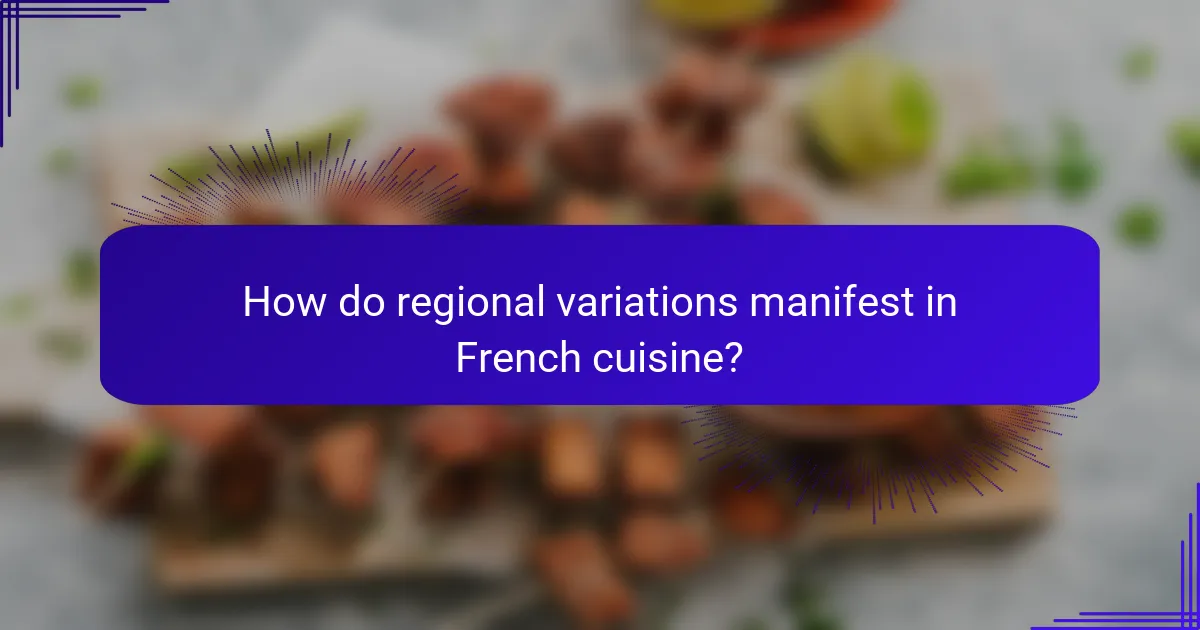
What is the Evolution of French Cuisine?
French cuisine has evolved significantly over centuries. It began in the medieval period with simple, rustic dishes. The Renaissance introduced new ingredients and techniques from Italy. The 17th and 18th centuries saw the rise of haute cuisine, emphasizing refinement and presentation. Classic French cooking methods were codified in the 19th century, establishing a foundation for modern culinary practices. The 20th century brought regional diversity and the influence of global cuisines. Today, French cuisine continues to adapt while maintaining its rich traditions.
How has French cuisine developed over the centuries?
French cuisine has developed significantly over the centuries, influenced by various historical events and cultural exchanges. In the Middle Ages, French cooking was characterized by heavy use of spices and sauces. The Renaissance introduced a focus on fresh ingredients and presentation, influenced by Italian culinary practices. The 17th century saw the rise of haute cuisine, emphasizing elaborate dishes and refined techniques. The 19th century brought regional variations, as local ingredients and traditions were celebrated. The 20th century introduced nouvelle cuisine, focusing on lighter dishes and artistic presentation. Today, French cuisine continues to evolve, integrating global influences while maintaining its rich heritage. The Michelin Guide, established in 1900, has played a crucial role in promoting and standardizing French culinary excellence.
What historical events have influenced the evolution of French cuisine?
The evolution of French cuisine has been influenced by several historical events. The Roman conquest introduced new ingredients and cooking techniques. The Middle Ages saw the rise of feasting and the use of spices from trade routes. The Renaissance brought Italian culinary influences, emphasizing presentation and flavor. The French Revolution democratized food, leading to the establishment of bistros. The industrial revolution modernized food production and preservation methods. World Wars prompted rationing, which altered cooking habits. Global exploration introduced new ingredients, expanding culinary diversity. Each event significantly shaped the culinary landscape of France.
How have cultural exchanges shaped French culinary practices?
Cultural exchanges have significantly shaped French culinary practices. Historical interactions with various cultures introduced new ingredients and techniques. The influence of Italian cuisine during the Renaissance brought pasta and tomato-based sauces to France. Additionally, the introduction of spices from Asia transformed flavor profiles in French cooking. Colonial trade routes facilitated the exchange of exotic ingredients like vanilla and cocoa. Immigrant communities have also contributed unique culinary traditions, enriching regional French dishes. These exchanges created a diverse culinary landscape that continues to evolve today. The blend of local and foreign influences is a hallmark of modern French cuisine.
What are the key characteristics of French cuisine?
French cuisine is characterized by its emphasis on high-quality ingredients and intricate techniques. It showcases a variety of flavors and textures, often using fresh herbs and spices. The cuisine is known for its regional diversity, with distinct dishes from areas like Provence and Normandy. Classic techniques such as sautéing, poaching, and braising are fundamental to its preparation. French cuisine often includes rich sauces, which enhance the overall flavor profile. Presentation is also a key aspect, reflecting artistry in plating. Additionally, French cuisine has historically influenced culinary practices worldwide, establishing standards in fine dining. The Michelin Guide, established in 1900, exemplifies the global impact of French culinary excellence.
What role do ingredients play in defining French cuisine?
Ingredients are fundamental in defining French cuisine. They shape flavor profiles and culinary techniques. France’s diverse regions contribute unique ingredients, such as herbs, cheeses, and meats. For example, Provence is known for its aromatic herbs, while Normandy is famous for its dairy products. Seasonal availability influences ingredient selection, ensuring freshness and quality. Traditional French dishes often highlight specific local ingredients, reinforcing regional identity. The use of high-quality, fresh ingredients is a hallmark of French culinary philosophy. This focus on ingredients elevates the overall dining experience in French cuisine.
How do cooking techniques contribute to the uniqueness of French dishes?
Cooking techniques play a crucial role in defining the uniqueness of French dishes. These techniques include methods such as sautéing, poaching, and braising. Each method enhances the flavors and textures of the ingredients used. For example, sautéing allows for quick cooking at high heat, creating a caramelized exterior. Poaching gently cooks ingredients in liquid, preserving their delicate flavors. Braising combines both wet and dry heat, resulting in tender and flavorful dishes.
French cuisine emphasizes precision and technique, often requiring specific skills. Techniques are often passed down through generations, maintaining traditional practices. The use of classic techniques contributes to the complexity and depth of flavors in French dishes. This commitment to technique is a hallmark of French culinary identity. The interplay of these methods results in distinctive regional variations across France. Each region showcases its own ingredients and techniques, further enriching the diversity of French cuisine.

What are the key influences on French cuisine?
Key influences on French cuisine include regional diversity, historical events, and cultural exchanges. France’s geography contributes to a variety of local ingredients. Each region has its own specialties, such as seafood in Brittany and cheese in Normandy. The French Revolution changed culinary practices, promoting the idea of gastronomy. Influences from neighboring countries, like Italy and Spain, also shaped French cooking. Additionally, the rise of haute cuisine in the 19th century established formal cooking techniques. French cuisine has been recognized by UNESCO as an intangible cultural heritage, highlighting its global impact. These factors collectively define the richness of French culinary tradition.
How have regional ingredients influenced French culinary traditions?
Regional ingredients have profoundly influenced French culinary traditions. Each region in France boasts unique agricultural products that shape local cuisines. For example, Provence is known for its herbs and olive oil, which enhance Mediterranean dishes. In Normandy, dairy products, particularly cream and butter, play a crucial role in traditional recipes. The seafood from Brittany is central to its culinary identity, influencing dishes like galettes and fish stews. Additionally, the use of local wines in cooking reflects the terroir concept, emphasizing the connection between food and its geographical origin. Historical practices, such as the use of seasonal ingredients, have also been pivotal in developing regional specialties. This regional diversity contributes to the richness and complexity of French cuisine, making it globally renowned.
What are the most significant regional specialties in French cuisine?
Significant regional specialties in French cuisine include Bouillabaisse from Provence, Coq au Vin from Burgundy, and Ratatouille also from Provence. Bouillabaisse is a traditional fish stew with roots in Marseille. Coq au Vin features chicken braised with wine, lardons, mushrooms, and garlic. Ratatouille is a vegetable dish made from eggplant, zucchini, and tomatoes. Other notable specialties are Quiche Lorraine from Lorraine and Tarte Tatin from the Loire Valley. Each dish reflects local ingredients and culinary traditions. French cuisine showcases a diverse range of flavors and techniques across its regions.
How does climate affect the ingredients used in different regions?
Climate significantly influences the ingredients used in different regions. In warmer climates, crops like tomatoes and peppers thrive. These ingredients are staples in Mediterranean cuisine. Conversely, cooler climates favor root vegetables and hardy grains. Regions such as Brittany utilize ingredients like potatoes and cabbage due to their climate. Additionally, humidity levels affect the types of herbs and spices that can be cultivated. For instance, Provence is known for its aromatic herbs, benefiting from a dry, sunny climate. Seasonal variations also dictate what ingredients are available throughout the year. This leads to distinct regional dishes that reflect local agricultural practices.
What impact did historical figures have on French cuisine?
Historical figures significantly shaped French cuisine through their culinary innovations and cultural influences. Chefs like Auguste Escoffier modernized cooking techniques and established the foundation of classical French cuisine. His work in the late 19th and early 20th centuries introduced a systematized approach to cooking, emphasizing sauces and presentation. Marie-Antoine Carême, a precursor to Escoffier, is known for his elaborate pastries and the development of the grand cuisine style. His influence extended to the use of seasonal ingredients and regional specialties.
Additionally, figures like Julia Child popularized French cooking in America, making it more accessible to the public. Her television shows and cookbooks introduced French techniques to a wider audience. The impact of these historical figures is evident in the global appreciation and adaptation of French culinary arts. Their contributions have led to the establishment of French cuisine as a benchmark in culinary education and practice worldwide.
Who are the notable chefs that transformed French cooking?
Auguste Escoffier, Julia Child, and Paul Bocuse are notable chefs who transformed French cooking. Escoffier modernized French cuisine in the late 19th century. He introduced the brigade system in kitchens, enhancing efficiency. Julia Child popularized French cooking in America during the 1960s. Her television shows and cookbooks made French cuisine accessible. Paul Bocuse is known for nouvelle cuisine, emphasizing fresh ingredients and presentation. He helped elevate French cuisine to global prominence. Each of these chefs made significant contributions that reshaped culinary practices. Their influence continues to be felt in kitchens around the world.
What culinary movements emerged from influential figures in French gastronomy?
French gastronomy has seen several culinary movements influenced by key figures. Notable movements include Haute Cuisine, Nouvelle Cuisine, and Cuisine du Terroir.
Haute Cuisine emerged in the 19th century, popularized by chefs like Marie-Antoine Carême. This movement emphasized elaborate presentation and rich flavors.
Nouvelle Cuisine gained traction in the 1970s, led by chefs such as Paul Bocuse. It focused on lighter dishes, fresh ingredients, and artistic presentation.
Cuisine du Terroir celebrates regional ingredients and traditional cooking methods. Influential figures like Alain Ducasse have championed this movement, highlighting local flavors.
These movements have shaped modern French cuisine, reflecting cultural shifts and culinary innovation.

How do regional variations manifest in French cuisine?
Regional variations in French cuisine manifest through distinct ingredients, cooking techniques, and traditional dishes. Each region showcases its local produce and cultural influences. For example, Provence is known for its use of herbs and olive oil. In contrast, Normandy features dairy products and apples. The coastal regions emphasize seafood, while the interior regions focus on meats and hearty dishes. Historical factors, such as trade routes and agricultural practices, shape these culinary differences. Additionally, regional specialties like bouillabaisse from Marseille and coq au vin from Burgundy highlight unique flavors. These variations contribute to the rich tapestry of French culinary heritage.
What are the distinct features of Northern French cuisine?
Northern French cuisine is characterized by its rich flavors and hearty ingredients. Key features include the use of dairy products, particularly cream and butter. Dishes often incorporate potatoes, leeks, and root vegetables due to the region’s agricultural practices. Seafood is prevalent, especially in coastal areas, with dishes like mussels and herring. Northern French cuisine also emphasizes the use of local beers in cooking, reflecting regional brewing traditions. Traditional dishes include “potjevleesch,” a meat terrine, and “tarte au sucre,” a sugar pie. These elements showcase the region’s blend of French culinary techniques and local produce. The influence of neighboring countries, such as Belgium, is also evident in the cuisine’s flavor profiles and ingredients.
How do the dishes from Northern France differ from those in Southern France?
Dishes from Northern France typically emphasize heartiness and richness, while Southern French dishes focus on freshness and lightness. Northern cuisine often features ingredients like potatoes, cream, and butter, reflecting its colder climate. Classic dishes include potjevleesch and carbonnade flamande, which are robust and filling. In contrast, Southern French cuisine highlights vegetables, olive oil, and herbs, showcasing Mediterranean influences. Signature dishes include ratatouille and bouillabaisse, which are vibrant and aromatic. The use of seafood is more prevalent in the South due to its coastal geography. These regional differences illustrate the diverse culinary landscape of France, shaped by climate and geography.
What ingredients are unique to Northern French cooking?
Unique ingredients in Northern French cooking include endives, maroilles cheese, and chicory. Endives are often used in salads and cooked dishes. Maroilles cheese is a strong-smelling cheese that adds depth to recipes. Chicory, particularly in the form of coffee or as a vegetable, is common in the region. Other notable ingredients are potatoes, which are essential in various dishes, and seafood from the North Sea. These ingredients reflect the region’s agricultural and maritime heritage.
What defines Southern French cuisine?
Southern French cuisine is defined by its emphasis on fresh, local ingredients and Mediterranean flavors. It showcases a variety of vegetables, herbs, and olive oil. Key ingredients include tomatoes, garlic, and seafood. This cuisine is influenced by the region’s climate and geography. Dishes often feature bold flavors and vibrant colors. Signature dishes include ratatouille and bouillabaisse. The use of herbs de Provence is prevalent. Southern French cuisine reflects a blend of cultural influences, including Italian and North African.
How does Mediterranean influence shape Southern French dishes?
Mediterranean influence shapes Southern French dishes through the use of fresh ingredients and bold flavors. This region emphasizes olive oil, herbs, and vegetables, reflecting Mediterranean agricultural practices. Ingredients like tomatoes, garlic, and bell peppers are staples in Southern French cuisine. The climate supports the growth of aromatic herbs such as thyme, rosemary, and basil, enhancing dish flavor profiles. Seafood is also prevalent due to the proximity to the Mediterranean Sea. Traditional dishes like ratatouille and bouillabaisse showcase this influence. The fusion of flavors and techniques creates a distinct culinary identity. Historical trade routes further facilitated the exchange of ingredients and cooking methods.
What are the signature dishes of Southern France?
Signature dishes of Southern France include ratatouille, bouillabaisse, and socca. Ratatouille is a vegetable stew made with eggplant, zucchini, and tomatoes. Bouillabaisse is a traditional fish stew originating from Marseille. It typically features various fish and shellfish, flavored with saffron and herbs. Socca is a chickpea flour pancake, popular in Nice. Other notable dishes are tapenade, a spread made from olives, and salade niçoise, a salad with tuna, green beans, and hard-boiled eggs. These dishes reflect the Mediterranean influences and local ingredients of the region.
How do French culinary traditions vary across the country?
French culinary traditions vary significantly across the country due to regional ingredients and cultural influences. Each region boasts unique dishes that reflect local agriculture and climate. For example, Provence is known for its use of herbs and olive oil, while Normandy features dairy products and apples. The coastal regions emphasize seafood, particularly in Brittany. In contrast, the interior regions like Burgundy focus on rich meats and wines. Additionally, Alsace combines French and German culinary elements, showcasing sauerkraut and sausages. These variations illustrate how geography and history shape French cuisine.
What are the unique cooking styles found in Eastern France?
Eastern France is known for its unique cooking styles, which include Alsatian, Lorraine, and Franche-Comté cuisines. Alsatian cuisine features dishes like choucroute garnie, a dish of sauerkraut with sausages and meats. Lorraine cuisine is famous for quiche Lorraine, made with eggs, cream, and bacon. Franche-Comté is known for its cheese, particularly Comté cheese, often used in fondue. These regional styles reflect the influence of neighboring countries, especially Germany and Switzerland. The use of local ingredients, such as sauerkraut and cheeses, highlights the distinct flavors of Eastern France. Each cooking style has historical roots, shaped by cultural exchanges and local traditions.
How does the cuisine of Western France reflect its cultural heritage?
The cuisine of Western France reflects its cultural heritage through the use of local ingredients and traditional cooking methods. Seafood is a prominent feature, influenced by the region’s extensive coastline. Dishes like moules marinières showcase the maritime culture. Additionally, the use of butter and cream in recipes highlights the influence of Normandy. The region is also known for its unique cheeses, such as Camembert and Livarot, which represent local dairy farming traditions. Festivals celebrating local produce, like the Fête de la Mer, emphasize the connection between cuisine and community. Historical influences, such as Celtic and Breton traditions, further shape the culinary landscape. Overall, Western French cuisine serves as a reflection of the area’s geography, history, and cultural practices.

What are some signature dishes of French cuisine?
Signature dishes of French cuisine include Coq au Vin, Bouillabaisse, and Ratatouille. Coq au Vin is a chicken dish braised with wine, lardons, and mushrooms. Bouillabaisse is a traditional fish stew originating from the Provence region, featuring various fish and shellfish. Ratatouille is a vegetable dish made from tomatoes, zucchini, eggplant, and bell peppers, typically seasoned with herbs. Other notable dishes are Quiche Lorraine, a savory pie filled with eggs and bacon, and Tarte Tatin, an upside-down caramelized apple tart. These dishes reflect the rich culinary traditions and regional diversity of France.
What are the most iconic French dishes and their origins?
Coq au Vin is a classic French dish originating from the Burgundy region. It consists of chicken slowly braised with wine, lardons, mushrooms, and garlic. Bouillabaisse, a traditional fish stew, hails from the port city of Marseille. This dish combines various fish and shellfish with aromatic herbs and spices. Ratatouille is a vegetable dish from Provence. It showcases the region’s fresh produce, including eggplant, zucchini, and bell peppers.
Escargots de Bourgogne, or snails baked in garlic butter, are a delicacy from Burgundy. They are often served as an appetizer. Tarte Tatin is an upside-down caramelized apple tart that originated in the Loire Valley. It was created by accident in the late 19th century.
Croissants, a flaky pastry, trace their roots to Austrian kipferl. They became popular in France during the 19th century. Quiche Lorraine, from the Lorraine region, is a savory pie made with eggs, cream, and bacon.
These dishes reflect regional ingredients and cooking techniques, showcasing the diversity of French cuisine.
How do classic dishes like Coq au Vin represent French culinary tradition?
Classic dishes like Coq au Vin embody French culinary tradition through their use of local ingredients and time-honored cooking techniques. Coq au Vin features chicken braised with wine, mushrooms, and lardons. This dish highlights the importance of regional wines, particularly Burgundy, in French cuisine. The method of slow cooking reflects the French emphasis on developing deep flavors over time.
Historically, Coq au Vin dates back to ancient Gaul, showcasing the influence of rustic cooking methods. The dish also represents the French value of using every part of the animal. This practice aligns with the concept of terroir, which emphasizes the connection between food and its geographical origin.
Furthermore, Coq au Vin is often prepared for communal gatherings, emphasizing the French tradition of sharing meals. The dish’s rich flavors and comforting nature make it a staple in French households. Overall, Coq au Vin serves as a culinary symbol of France’s rich agricultural heritage and gastronomic culture.
What role do desserts play in French cuisine, and what are the most popular ones?
Desserts are a significant aspect of French cuisine, celebrated for their artistry and flavor. They often conclude meals and showcase culinary skills. Traditional French desserts include pastries, cakes, and custards. Popular examples are crème brûlée, macarons, and tarte Tatin. These desserts reflect regional ingredients and techniques. French desserts are also integral to cultural celebrations and holidays. Their preparation often involves meticulous techniques, emphasizing quality and presentation. The global influence of French desserts has made them iconic in international cuisine.
What modern interpretations exist of traditional French dishes?
Modern interpretations of traditional French dishes include innovative techniques and ingredient substitutions. Chefs often incorporate global flavors into classic recipes. For example, coq au vin may feature Asian spices or be served with rice instead of potatoes. Ratatouille can be transformed into a layered vegetable tart or a puree. Classic French onion soup is sometimes reimagined as a deconstructed dish with onion confit and cheese foam. Duck confit may be served in tacos or as a filling for gourmet sandwiches. These adaptations reflect contemporary culinary trends and a focus on seasonal ingredients. The rise of plant-based diets has also led to vegan versions of traditional dishes, such as vegan boeuf bourguignon. These modern interpretations maintain the essence of French cuisine while embracing innovation.
How have contemporary chefs reimagined classic French recipes?
Contemporary chefs have reimagined classic French recipes by incorporating global flavors and modern techniques. They often use local and seasonal ingredients to enhance traditional dishes. Techniques such as sous-vide and molecular gastronomy are frequently applied. Chefs also focus on presentation, turning meals into visual art. For example, classic coq au vin may be served as a deconstructed dish. Additionally, vegetarian and vegan adaptations are becoming popular. These innovations reflect changing dietary preferences and sustainability concerns. Overall, the evolution of French cuisine embraces creativity while honoring its rich heritage.
What are the trends in French cuisine today?
Current trends in French cuisine emphasize sustainability and local sourcing. Chefs are increasingly focusing on seasonal ingredients. This shift promotes a farm-to-table approach. Plant-based dishes are gaining popularity among French diners. Traditional recipes are being reinterpreted with modern techniques. Global influences are also shaping contemporary French menus. Fusion cuisine is becoming more common in urban areas. Overall, French cuisine is evolving to reflect changing consumer preferences.
What tips can enhance the experience of French cuisine at home?
To enhance the experience of French cuisine at home, focus on authentic ingredients. Use high-quality butter, fresh herbs, and seasonal vegetables. Invest in essential kitchen tools like a mandoline and a good chef’s knife. Master basic techniques such as sautéing, braising, and making sauces. Pair dishes with appropriate wines to elevate flavors. Set the table with care, using elegant tableware to create a French dining atmosphere. Explore regional recipes to experience the diversity of French cuisine. Finally, take your time to savor the meal, as dining is a cherished ritual in French culture.
How can one replicate authentic French flavors in home cooking?
To replicate authentic French flavors in home cooking, focus on using traditional ingredients and techniques. Incorporate staples like fresh herbs, garlic, and quality butter. Use regional ingredients specific to various French regions, such as lavender from Provence or seafood from Brittany. Master classic cooking methods, including sautéing, braising, and poaching.
Season dishes with salt and pepper to enhance the natural flavors. Consider using homemade stocks for soups and sauces, as they provide depth. Emphasize the importance of presentation, as French cuisine values aesthetics.
Research shows that authentic flavors often come from attention to detail in preparation and ingredient selection. For example, a study by the Culinary Institute of America highlights the significance of fresh, local produce in achieving true French taste.
What are essential tools and ingredients for cooking French dishes?
Essential tools for cooking French dishes include a chef’s knife, cutting board, and sauté pan. A chef’s knife is crucial for precise chopping and slicing. A sturdy cutting board provides a stable surface for food preparation. A sauté pan allows for even cooking and browning of ingredients.
Key ingredients in French cuisine consist of butter, herbs, and fresh vegetables. Butter is a foundational fat used for flavor and richness. Fresh herbs like thyme and parsley enhance the taste of many dishes. Vegetables such as onions, carrots, and garlic form the base of numerous classic recipes.
Together, these tools and ingredients create the foundation for authentic French cooking. They are integral to preparing signature dishes like Coq au Vin and Ratatouille.
The main entity of the article is French cuisine, which has undergone significant evolution over centuries influenced by historical events, cultural exchanges, and regional diversity. The article outlines the development of French culinary practices from medieval rustic dishes to the refinement of haute cuisine, highlighting key historical figures and movements that shaped its identity. It discusses the importance of regional ingredients and variations, detailing signature dishes from different areas of France, such as Coq au Vin and Bouillabaisse. Additionally, the article examines contemporary trends and modern interpretations of traditional recipes, emphasizing the enduring significance of French cuisine in global culinary practices.
